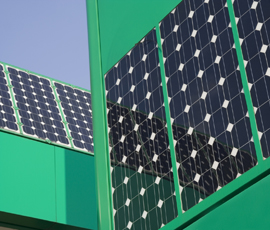Nov 8 2013
The high frequencies and pitch found in pop and rock music cause vibrations that enhanced energy generation in solar cells containing a cluster of ‘nanorods’, leading to a 40 per cent increase in efficiency of the solar cells.
 Solar cells containing nanorod clusters
Solar cells containing nanorod clusters
The study has implications for improving energy generation from sunlight, particularly for the development of new, lower cost, printed solar cells.
The researchers grew billions of tiny rods (nanorods) made from zinc oxide, then covered them with an active polymer to form a device that converts sunlight into electricity.
Using the special properties of the zinc oxide material, the team was able to show that sound levels as low as 75 decibels (equivalent to a typical roadside noise or a printer in an office) could significantly improve the solar cell performance.
“After investigating systems for converting vibrations into electricity this is a really exciting development that shows a similar set of physical properties can also enhance the performance of a photovoltaic,” said Dr Steve Dunn, Reader in Nanoscale Materials from Queen Mary’s School of Engineering and Materials Science and co-author of the paper.
Good Vibrations: harvesting energy from sound - Professor Steve Dunn
Scientists had previously shown that applying pressure or strain to zinc oxide materials could result in voltage outputs, known as the piezoelectric effect. However, the effect of these piezoelectric voltages on solar cell efficiency had not received significant attention before.
"We thought the soundwaves, which produce random fluctuations, would cancel each other out and so didn't expect to see any significant overall effect on the power output," said James Durrant, Professor of Photochemistry at Imperial College London, who co-led the study.
"We tried playing music instead of dull flat sounds, as this helped us explore the effect of different pitches. The biggest difference we found was when we played pop music rather than classical, which we now realise is because our acoustic solar cells respond best to the higher pitched sounds present in pop music," he concluded.
The discovery could be used to power devices that are exposed to acoustic vibrations, such as air conditioning units or within cars and other vehicles.
Co-author Dr Joe Briscoe also from Queen Mary’s School of Engineering and Materials Science, commented: “The whole device extremely simple and inexpensive to produce as the zinc oxide was grown using a simple, chemical solution technique and the polymer was also deposited from a solution."
Dr Dunn added: “The work highlights the benefits of collaboration to develop new and interesting systems and scientific understanding.”
Interested to know more? Watch Drs Dunn and Briscoe in action